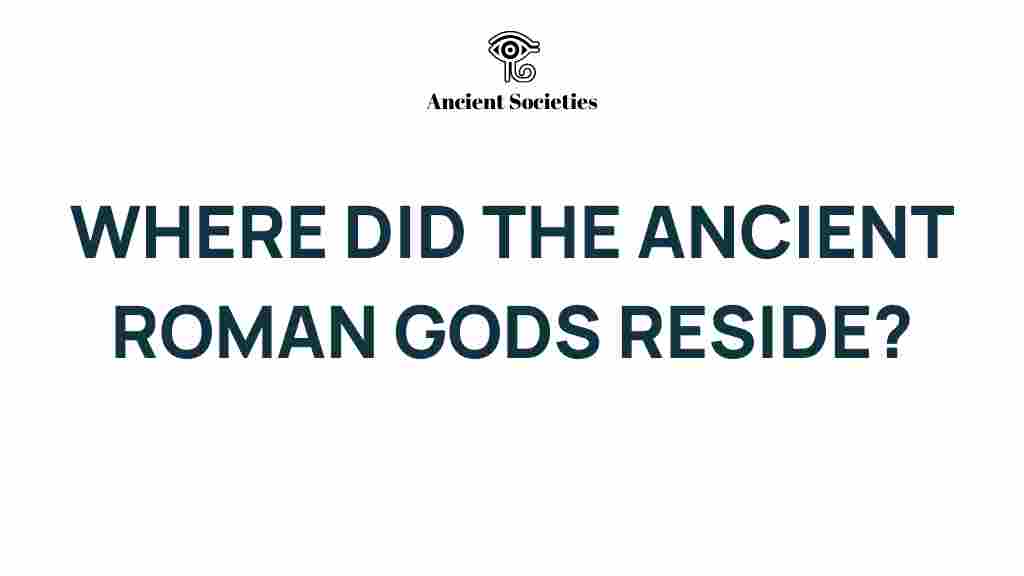Unveiling the Abodes of Ancient Roman Gods
Ancient Roman gods played a pivotal role in the cultural and religious life of Rome, influencing everything from politics to daily routines. The architecture and temples dedicated to these deities not only served as places of worship but also as symbols of the Roman Empire’s grandeur. Understanding the mythology, history, and architectural significance of these divine abodes offers us a glimpse into the rich tapestry of Roman culture.
The Divine Pantheon: Who Were the Ancient Roman Gods?
The ancient Roman gods were numerous, each representing different aspects of life, nature, and society. Major deities included:
- Jupiter – King of the gods, associated with thunder and lightning.
- Juno – Queen of the gods, protector of women and marriage.
- Neptune – God of the sea, earthquakes, and horses.
- Minerva – Goddess of wisdom and warfare.
- Venus – Goddess of love and beauty.
These gods were revered in various ways, with temples constructed in their honor throughout the empire, reflecting the importance of worship in Roman society.
The Architecture of Worship: Temples of the Gods
The temples dedicated to the ancient Roman gods were architectural marvels, showcasing the skill and artistry of Roman builders. Key features included:
- Columns: Temples often featured grand columns, such as the Corinthian and Ionic styles, emphasizing height and grandeur.
- Porticos: Many temples had open porches that invited worshippers to enter.
- Statues: Inside, temples housed magnificent statues of the gods, crafted from marble and other precious materials.
- Altars: Altars were central to the worship rituals, where offerings were made to appease the deities.
One of the most famous examples is the Pantheon in Rome, originally built as a temple for all gods, showcasing the innovation of Roman engineering with its massive dome and oculus.
Step-by-Step Process: How Temples Were Constructed
The construction of temples dedicated to the ancient Roman gods followed a meticulous process:
- Site Selection: Temples were often built on elevated ground to signify their importance.
- Design Planning: Architects and priests collaborated to design the layout, ensuring it conformed to religious guidelines.
- Material Sourcing: High-quality materials like marble were sourced, often from distant lands.
- Construction: Skilled laborers and craftsmen worked on the site, using advanced techniques for the time.
- Decoration: Once the structure was complete, intricate sculptures and frescoes adorned the temple.
This process not only highlighted the architectural prowess of the Romans but also their commitment to their gods through magnificent structures.
The Role of Temples in Roman Religion
The temples served as the heart of religious life in ancient Rome. They were places where the community gathered for important rituals and festivals. Key functions included:
- Rituals: Regular ceremonies were held to honor the gods, including sacrifices and offerings.
- Festivals: Special festivals celebrated the gods’ myths, often involving games, feasts, and public displays.
- Divination: Priests interpreted signs and omens to guide decisions, believing these were messages from the gods.
The temples were not just physical structures; they embodied the Roman worldview where the divine influenced every aspect of life.
Challenges in Worship: Troubleshooting Tips
- Problem: Lack of participation in rituals.
- Solution: Organize community events to rekindle interest and participation in temple activities.
- Problem: Misinterpretation of omens.
- Solution: Training priests in the art of divination to ensure accurate readings.
- Problem: Deterioration of temple structures.
- Solution: Regular maintenance and restoration efforts to preserve these sites.
Addressing these challenges was essential in maintaining the temples as vibrant centers of worship.
The Cultural Heritage of Ancient Roman Temples
The temples of ancient Roman gods are more than just relics of the past; they are a vital part of our cultural heritage. They offer insights into:
- Religious Practices: Understanding the rituals and beliefs of the Romans enriches our knowledge of their society.
- Art and Architecture: The design and construction techniques influence modern architecture.
- Historical Context: Studying these temples helps us comprehend the socio-political landscape of ancient Rome.
Many of these sites are protected as UNESCO World Heritage Sites, emphasizing their global significance.
Conclusion: The Legacy of Ancient Roman Gods
The ancient Roman gods and their temples stand testament to a civilization that revered the divine and integrated it into everyday life. Their mythology and the grand architecture of the temples reflect a rich history that has shaped Western culture. As we explore these ruins, we connect with a past that continues to influence our understanding of religion, art, and society today.
To delve deeper into the history of ancient Rome, consider visiting this resource for more information. For those interested in exploring modern interpretations of these divine abodes, check out this article.
This article is in the category Culture and created by AncientSocieties Team
